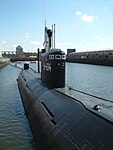Steinwerder

Steinwerder (German "stein" stone, "werder" (archaic) island or peninsula, translation "stone peninsula") is a quarter of Hamburg, Germany in the borough Hamburg-Mitte on the southern bank of the river Elbe. It is a primarily maritime industrial location, with a resident population in 2017 of only 39. Local landmarks include two music theatres, the Steinwerder ends of the Old Elbtunnel and Köhlbrand Bridge, and the shipyard of Blohm+Voss in which the old Pilot House still stands. Until 1946, the name was written as Steinwärder. (See also German wikipedia). It seems to have lent this name to a ship built in 1848 in Altona (on the opposite side of the harbour). This ship was notable for 5 migration voyages from Hamburg to Port Adelaide between 1849 and 1863, after which it was sold and renamed.
Excerpt from the Wikipedia article Steinwerder (License: CC BY-SA 3.0, Authors, Images).Steinwerder
Breslauer Straße, Hamburg Steinwerder
Geographical coordinates (GPS) Address Nearby Places Show on map
Geographical coordinates (GPS)
| Latitude | Longitude |
|---|---|
| N 53.534444444444 ° | E 9.9572222222222 ° |
Address
Leuchtturm Ellerholzhöft
Breslauer Straße
20457 Hamburg, Steinwerder
Germany
Open on Google Maps






